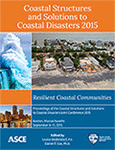Coastal Structures and Solutions to Coastal Disasters Joint Conference 2015
Effects of Low-Crested Living Shoreline Breakwaters on Wave Setup
Publication: Coastal Structures and Solutions to Coastal Disasters 2015: Resilient Coastal Communities
ABSTRACT
This study presents a field investigation to qualitatively examine wave setup induced water ponding/piling-up behind a low-crested engineered oyster reef breakwater structure. Field monitoring of a prototype breakwater segment located near Alabama Port, Alabama, in May 2015 did not reveal significant changes in the mean water levels near the breakwater prototype location. The typical wave climate observed during the monitoring period consisted of short-crested wave heights of less than 0.1 m with wave transmission as high as 78% of the incident wave height. Collectively, the mild wave climate and the poor wave attenuation capabilities of the low-crested breakwater structure likely prevented the development of wave setup during the monitoring period. It is recommended that further studies continue to investigate hydrodynamic interactions related to low-crested oyster reef breakwater structures used in living shoreline stabilization projects, particularly during storm events or more energetic conditions.
Get full access to this article
View all available purchase options and get full access to this chapter.
REFERENCES
Calabrese, M., Vicinanza, D., and Buccino, M. (2003). “2D Wave Set Up behind Low Crested and Submerged Breakwaters.” Proc, 13th International Offshore and Polar Engineering Conference, Honolulu, HI, 831-836.
Dalrymple, R. A. and Dean, R. G. (1971). “Discussion of Piling-up behind Low and Submerged Permeable Breakwaters.” Journal of Waterways, Harbors, and Coastal Engineering Division, 97(2), 423-427.
Dalrymple, R. A. and Dean, R. G. (1991). Water Wave Mechanics for Engineers and Scientists. Prentice-Hall.
Douglass, S. L. (2013). “Living Shorelines in the Gulf of Mexico”. Living Shorelines for Coastal Erosion Protection in a Changing World Workshop, NY Sea Grant, Hauppauge, NY, May 15.
Douglass, S. L., Webb, B. M., and Servold, K. P. (2014). “A Primer on Coastal Engineering for Living Shorelines”. Restore America’s Estuaries Conference, Washington, DC, Nov. 3.
Gibbons, D. T., Jones, G., Siegel, E., Hay, A., and Johnson, F. (2005). “Performance of a New Submersible Tide-Wave Recorder.” Proc, MTS/IEEE, OCEANS, 1057-1060.
Heck, K. L., Cebrian, J., Powers, S. P., Gericke, R. L., Pabody, C., and Goff, J. (2012). “Final Monitoring Report to the Nature Conservancy: Coastal Alabama Economic Recovery and Ecological Restoration Project: Creating Jobs to Protect Shorelines, Restore Oyster Reefs and Enhance Fisheries Productions.” Dauphin Island Sea Lab and University of South Alabama. NA09NMF4630304.
Kimball, S. (2011). “Diurnal and Seasonal Variations in Wind Speed and Direction In and Around Mobile, Bay, Alabama.” Proc, 36th NWA Annual Meeting, Birmingham, AL.
Longuet-Higgins, M. S. (1967). “On the Wave-Induced Difference in Mean Sea Level between the Two Sides of a Submerged Breakwater.” Journal of Marine Research, 25(2), 148-153.
McKee, J. (2010). “Analysis and Design Plan Coastal Alabama Economic Recovery and Ecological Restoration Project.” Dauphin Island Sea Lab.
Morris, J. T., Sundareshwar, P. V., Nietch, C.T., Kjerfve, B., and Cahoon, D. R. (2002). “Responses of Coastal Wetlands to Rising Sea Level.” Ecology, 83(10), 2869-2877.
Roland, R. M. and Douglass, S. L. (2005). “Estimating Wave Tolerance of Spartina Alterniflora in Coastal Alabama.” Journal of Coastal Research, 21(3), 453-463.
Scyphers, S. B., Powers, S. P., Heck, K. J., and Byron, D. (2011). “Oyster Reefs as natural Breakwaters Mitigate Shoreline Loss and Facilitate Fisheries.” PloS one, 6(8).
Servold, K. P. (2015). “Observations of Wave Setup and Transmission behind Low-Crested Artificial Reef Breakwaters.” M. S. Thesis, University of South Alabama, Mobile, AL.
Sorensen, R. M. (2006). Basic Coastal Engineering, 3rd Edition, Springer Science and Business Media, Inc., Bethlehem, PA.
US Army Corps of Engineers (USACE). (1984). Shore Protection Manual. Army Engineer Waterways Experiment Station, Vicksburg, MS.
Webb, B. M. (2011). The Coastal Processes of Mon Louis Island. Mobile Bay National Estuary Program.
Webb, B. M., Douglass, S. L., and Servold, K. (2013). “Living shorelines: how much coastal engineering do you need?” Coastal and Estuarine Research Federation, Nov. 3-7, San Diego, CA.
Information & Authors
Information
Published In
Coastal Structures and Solutions to Coastal Disasters 2015: Resilient Coastal Communities
Pages: 421 - 431
Editors: Louise Wallendorf, U.S. Naval Academy and Daniel T. Cox, Ph.D., Oregon State University
ISBN (Online): 978-0-7844-8030-4
Copyright
© 2017 American Society of Civil Engineers.
History
Published online: Jul 11, 2017
Published in print: Jul 11, 2017
Authors
Metrics & Citations
Metrics
Citations
Download citation
If you have the appropriate software installed, you can download article citation data to the citation manager of your choice. Simply select your manager software from the list below and click Download.
